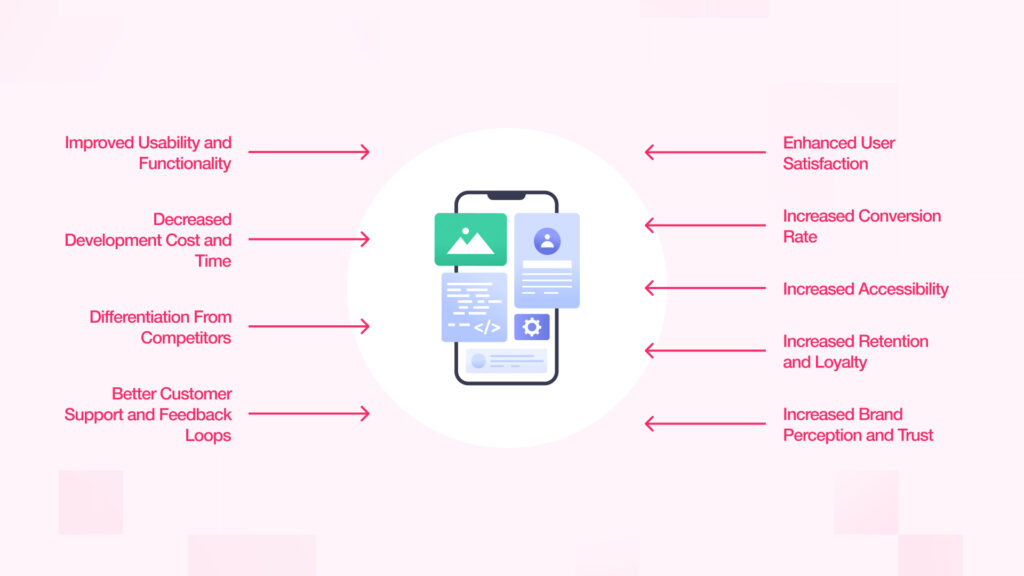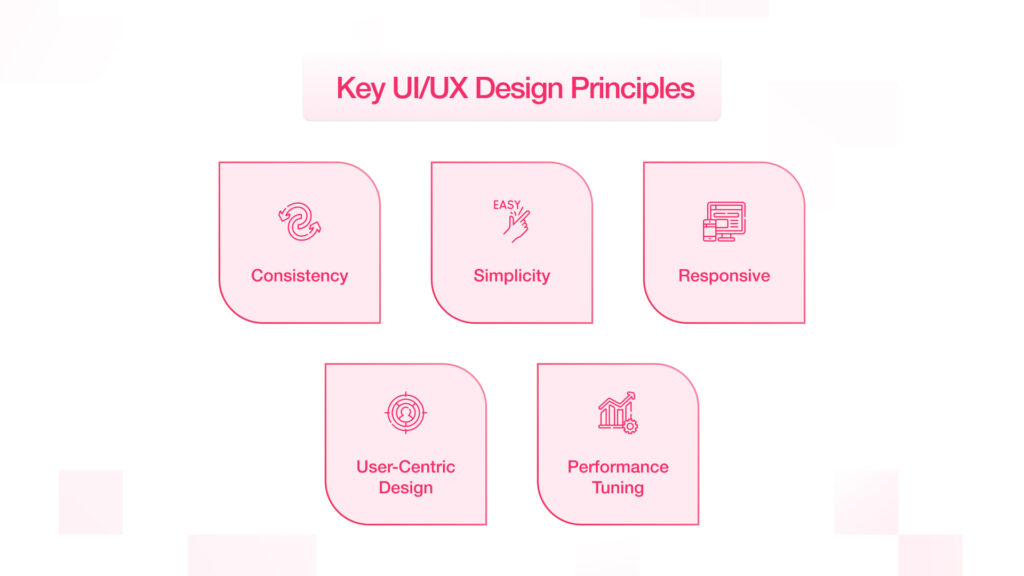How UI/UX Design Drives Software Success?

While creating software that meets the needs of users and quickly becomes distinct from competitors is a challenge in today’s highly competitive digital landscape. The most critical part of the software uptake is the UI/UX design. A well-designed UI/UX could influence the use of a product by driving user satisfaction, user engagement, and retention to save time and effort in drawing them to a specific application or software. In this article, we are going to discuss how UI/UX Design boost software success: its impact on user satisfaction and conversion rates.
UI/UX design is so much more than designing pretty applications or websites; it is designing a whole experience that matches the needs and behavior patterns of users, so that every interaction feels intuitive and meaningful.
Understanding UI/UX Design
UI (User Interface) and UX (User Experience) designers shape the product experience; however, their approaches do not always align. While UI design comprises visual elements like layout, color scheme, typography, buttons, and other interactive elements, UX is an overall experience a user has with a product.
UI Design (User Interface): UI is the visual representation of a product and includes graphics, colors, typefaces, buttons, and several other interactive elements. A user directly interacts with it; a good UI must not only be nice to look at but also easy to walk through.
UX Design (User Experience): On the other hand, UX design is about how the experience gets conceived by a user, while interacting with a product. It comprises how easily enjoyable tasks are performed by the user, how the product meets the user’s need, and how it solves pain points along with estimating usability, accessibility, and user satisfaction.
UI design and UX design are very important aspects of any product, and they both need to work together in order to come up with a design that not only looks good but also has a smooth-running experience for the customer.
Why UI/UX is Important for Software Success

Improved Usability and Functionality
Software that’s difficult to use will frustrate users, leading to decreased engagement and high bounce rates. A major component of good UX design is making software as easy to use as possible. This involves understanding the user’s journey and removing obstacles that prevent them from completing tasks efficiently.
For example, if a user struggles to find essential features or performs tasks in a complicated manner, they are likely to abandon the software. Well-implemented UX design takes into account the users’ needs and helps present information in a logical, organized manner, making navigation straightforward and intuitive. Similarly, UI design ensures that the interface is clean and consistent, further enhancing the usability of the software.
Enhanced User Satisfaction
It’s very important for any software to keep user satisfaction because it makes the software’s success last longer. This creates a continued tendency to return, recommend, and feedback on improvement through gainful comments. A very successful UI/UX needs to have an understanding of what the user likes, prefers, behaves, and expects from experience.
Mobile apps tend to have that draggy interface or too many websites for navigation, which turns off a user from their app’s conveniences. On the other hand, there’s a high probability that a software application that provides a seamless experience with every action feeling logical and satisfying would induce loyal patrons towards it. A thoughtful design in UX will more likely keep users coming back through high user retention and ensure consistent user participation.
Increased Conversion Rate
The product design can affect in making users convert into customers, it can be anything – from the user sign-up process to the entire flow of purchasing or the subscription model; it should be seamless and smooth in every step. In fact, studies have shown that poor UX design is one of the main reasons why users abandon websites or apps.
For instance, if a website has a complicated checkout process or unclear call to action buttons, that will push people toward leaving before finishing their purchases. Now intuitive navigation, clear instructions, and good visual treats can lead to higher conversion rates. UI/UX designers follow a user-centric strategy that guides or prompts users to take action at every touchpoint of the software.
Decreased Development Cost and Time
Another key aspect of spending money on good UI/UX design is that it ultimately saves time and money. Designers categorize users’ needs, preferences, and potential issues during the design phase. This helps developers mitigate the possibility of costly redesigns and feature changes during late stages of project development.
Usability testing and/or user research done prior to product launch can be helpful in highlighting potential concerns impacting user experience. Designers address these issues during the design phase to minimize the risk of making major changes or fixes after deployment. That makes development much smoother and brings the product to market much sooner.
Looking for a Partner in Your Development Journey?
We Can Help!
Differentiation from Competitors
In the crowded software market of the present, it is now important to focus on distinguishing a product from competitors. UI/UX design becomes an important differentiator for software products from a visual and functional perspective. A unique design, if applied in the right way, will grant a product an edge over competitors when users are forced to choose between more or less similar products.
Take a prime example: a beautifully designed and easy-to-use mobile app will attract users more than a mobile app that is awkward to navigate (however poorly) if both apps offer more or less the same functionality. Good UX design creates an emotional engagement with the users, who therefore feel more involved in the product, which, in turn, engenders loyalty toward the brand.
Increased Accessibility
Such software becomes accessible to a broader audience since this factor would allow users of any kind to utilize the tool efficiently. Accessible products would be able to reach more users, including persons with disabilities. The UI/UX designers are highly involved in making software more inclusive, as they have to implement the stipulations in accessibility guidelines and allow features like screen reader compatibility, keyboard navigation, and others.
It is by way of making life easier or simply improving everything and not just a legal compliance. Software accessibility improves loyalty amongst customers with regard to the product as well as the customer experience as all can take advantage of what it provides, regardless of abilities.
Better Customer Support and Feedback Loops
UI/UX design helps cut down on the need for customer service, creating software that is more understandable and self-explanatory. When a user faces a problem, a well-thought-out design would facilitate easy user access to assistance or feedback. An FAQ section that is easily accessible, live chat, or user-guides incorporated in the software would also enable the user to handle the problem without contacting support.
A strong UX design will also encourage constant feedback loops, enabling users to easily provide suggestions or report problems. This feedback will then inform updates and improvements to the application, ensuring future iterations will evolve with users’ needs and expectations.
Improved Retention and Loyalty
The essential role that UI/UX design plays in user retention and brand loyalty can never be overemphasized. Users are more likely to revisit an app or website with a pleasant, user-friendly experience. Therefore, the design should always make it useful and easy for users, laying emphasis on meeting their needs and expectations, leaving them feeling that the software is not just functional, but also a precious tool that makes their lives easier. When users build positive experiences with a product, the likelihood of their loyalty, continued use, and recommendation to others also increases, creating a growth loop.
Continuously evolving the UI/UX on user feedback keeps the product relevant and up to date with changing user tastes. As the software grows and adapts to user expectations, this enforces the trust that users have built around the product itself, translating itself into customer relationships that last longer.
Increased Brand Perception and Trust
A great and perfect UI/UX design can increase the brand perception of the company and position it more as professional-looking, trustworthy, and customer-focused. Design elements such as colors, fonts, and the whole layout of the interface work together in communication of the company’s values and what they stand for. A consistent, well-shaped user experience can instill confidence in users that they are using a good, reliable product.
In terms of designing for the end user, a well-designed product contributes to a good view regarding the brand, while poor design can destroy users’ relationship with the brand and cause them to question its credibility. A user may associate an unpleasant or confusing experience with the product or the company behind it at the other end of the spectrum and damage customer trust and brand loyalty in the long run. A good UI/UX design is therefore much more than just working for functionality; it plays a very important role in establishing and maintaining good brand relationships.
Need a Reliable UI/UX partner to help grow your Business?
Our Experts Can Help!
Key UI/UX Design Principles That Drives Software Success

- Consistency: Ensure design elements, layouts, and navigations are consistent across the software. This helps users get accustomed to the interface quickly and reduce confusion and frustration.
- Simplicity: Avoid clutter with lesser features that would overwhelm any user. Focus on only what is necessary to accomplish the user’s goal.
- Responsive: Develop applications that work seamlessly on all devices and all screen sizes so that the end-user experience is the same, regardless of the platform.
- User-Centered Design: Involve your target audience in every stage of the design process. Employ user research, usability testing, and feedback to ensure that your design holds promise for users.
- Performance Tuning: The UI/UX design must also be focused on the software’s performance. It doesn’t matter how great the design is; if a user’s experience is slow or with lags, everything gets ruined; therefore, optimization for speed and efficiency is a must in this context.
Conclusion
It is a UI/UX design that can make or break a software product. When user needs are placed first, the underlying software becomes a charm for users, leading to retention, conversion, and then success. Therefore, irrespective of whether you are developing a new application, doing an upgrade on an old platform, or starting a site, investing in high-quality UI/UX design must be your priority for your software to meet business and user expectations.
 Shopify
Shopify










